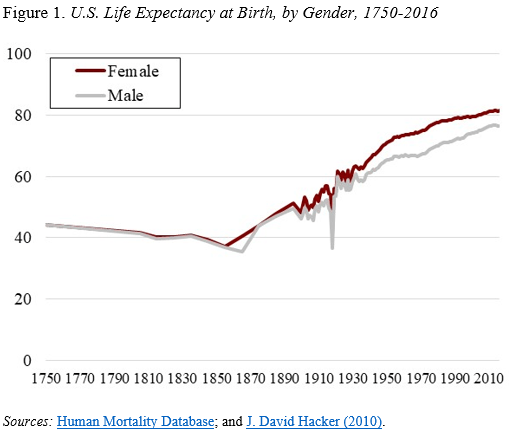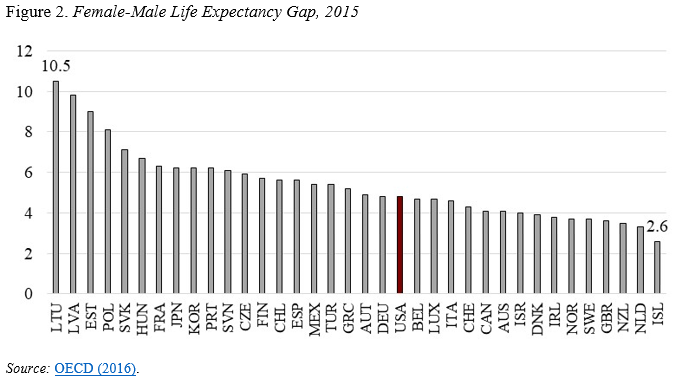
Women Live Longer than Men Everywhere
Alicia H. Munnell is a columnist for MarketWatch and senior advisor of the Center for Retirement Research at Boston College.
Female longevity wasn’t always so common.
In 2016, life expectancy at birth for women in the United States was 81.1, five years longer than that for men. Everywhere in the world, without exception, women live longer than men. However, a recent study by Claudia Goldin and Adriana Lleras-Muney points out that women did not always have a survival advantage. In the United States, data going back to 1750 show that the longevity gap between women and men did not appear until the late 19th century (see Figure 1). Since then, the gap has increased, reaching a peak at about 7.7 years in the 1970s before declining to about 5 years in the last decade.

The authors attribute the improvement in female life expectancy to the decline in infectious diseases. Those exposed to infectious diseases at young ages suffer permanent damage to the heart and other organs, and Massachusetts data show that infectious diseases disproportionately affected females.
Although the study does not tackle the bigger question of why women live longer than men, my colleague Angie Chen reports that other researchers have suggested that women may have a biological advantage. Specifically, estrogen lowers LDL (bad cholesterol), increases HDL (good cholesterol), and therefore reduces the risk of cardiovascular disease. Testosterone, on the other hand, may do the opposite. Additionally, women have two X chromosomes, which means that women keep two copies of every gene. As cell replication begins to slip with age, men do not have a backup, putting them at a greater risk of disease.
In the United States, behavioral factors also clearly played a role. Men started smoking earlier than women and tended to be heavier smokers than women. Men also are more likely to drink excessive amounts of alcohol, although the gap is narrowing. Furthermore, men are also more likely to overeat, and studies have shown that obesity increases the risk of heart disease, stroke, Type 2 diabetes, high systolic blood pressure, and certain types of cancer.
Smoking patterns in the United States probably explain why the gap between female and male life expectancy has been narrowing. Smoking affects life expectancy with an average delay of two to three decades. The prevalence of smoking among men peaked at close to 80 percent in the 1940s-1950s and began to decline steadily in the 1960s. The unfavorable impact on mortality for men grew from 1950 to 1990, after which the decline in smoking began to have a favorable effect on life expectancy. Smoking peaked more than a decade later for women, albeit at a much lower level than for men. The unfavorable impact of smoking on life expectancy for women increased from 1980 to 2000, and the favorable effect from decreased smoking is just now beginning to be observed.
The United States is about in the middle of OECD countries in terms of the gap between female and male life expectancy (see Figure 2).

It would be interesting to see how the female/male life expectancy gap varies across the United States by geography and by race. In my next life, I want to be a demographer.







